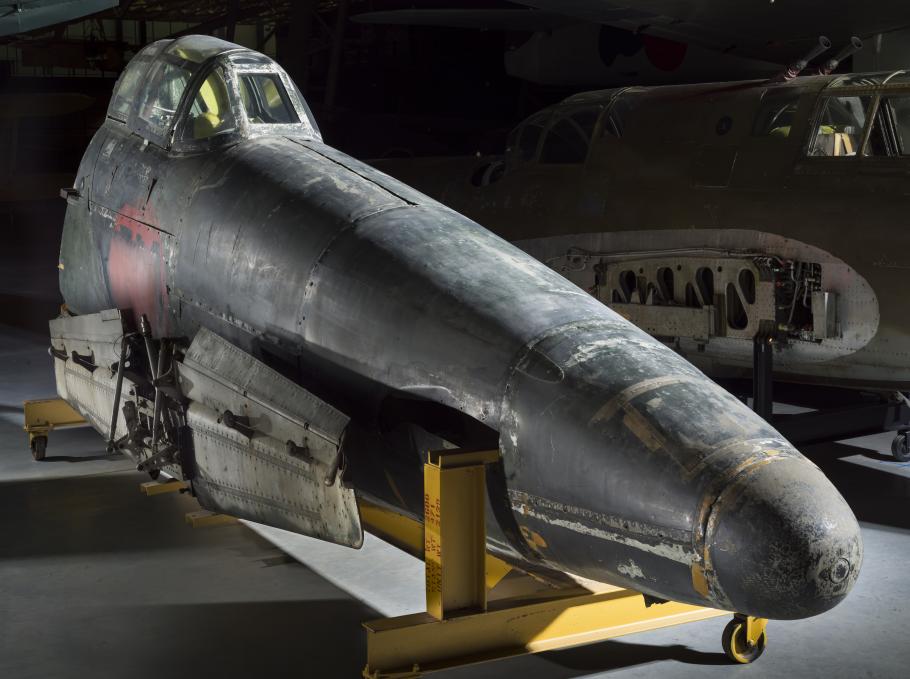Japan's J7W1 Shinden was the only World War II aircraft of canard configuration that any combatant ordered into production. Canard is a French term that has an obscure original meaning used by aircraft designers. Then, as now, canard describes an aircraft with the main wing mounted at the rear of the fuselage and a smaller wing fixed to the front. In the United States, the Curtiss-Wright company and the Army Air Corps also experimented with a canard aircraft, the Curtiss XP-55 Ascender (see NASM collection). However, the J7W1 was more advanced. Though innovative and unusual, neither airplane progressed past the early prototype stage.
Captain Masaoki Tsuruno led the effort to design the Shinden. A member of the Technical Staff of the Japanese Navy, he envisioned a radical design to counter new Allied aircraft with superior performance over existing Japanese types. From the beginning, Tsuruno believed a turbojet engine would propel the ultimate Shinden. To prove the fundamental concept, the staff of the First Naval Air Technical Arsenal based at Yokosuka, designed and built three MXY6 canard gliders out of wood. These aircraft began flight trials in the fall of 1943. They featured a moderately swept wing with two vertical tail surfaces mounted on the main wing inboard of the ailerons. The Navy later powered one glider with a small 4-cylinder engine.
After a promising series of tests, it was time to build and test a pre-production prototype. The Navy ordered the Kyushu Hikoki K. K. firm to design a high-performance, canard interceptor despite the company's lack of experience with such unorthodox aircraft. Availability, not expertise, dictated this choice. Firms that were more capable were already operating at full capacity and could not accommodate a brand new aircraft design. The Navy had to reinforce the Kyushu design staff with additional engineers, including Tsuruno, transferred from Kugisho. Work began in June 1944 and the first of two prototypes was finished ten months later.
Kyushu engineers mounted the engine backwards inside the rear half of the fuselage. The radial, air-cooled power plant drove a 6-blade, pusher propeller on the end of an extended drive shaft. With the propeller fitted at the tail, it was necessary to use a tricycle landing gear consisting of one wheel and strut mounted under the nose and two under the wings. An auxiliary wheel was attached to the bottom of each vertical fin and these wheels were fixed and not retractable. The pilot could retract the three main landing gear struts and wheels. Armament consisted of four 30 mm, Type 5 cannon placed in the nose. The weight of these large cannons helped to balance the weight of the engine and propeller at the back of the fuselage. Each gun could fire 450 rounds per minute. This was a very powerful armament package for the time.
In an unusual move dictated by the urgent needs of the war, the Navy ordered the Shinden into production even before the first flight. They planned to produce 150 of these machines each month at two production plants. Engine cooling problems, delays in the delivery of critical equipment for each airframe, and nationwide chaos felt in every part of the aircraft industry kept the J7W1 grounded until August 3, 1945. This day, Captain Tsuruno made the first flight. He took the Shinden aloft only twice more, on the 6th and the 9th of August. The war ended six days later. Tsuruno must have suspected that the end was near but he remained a cautious and conservative test pilot. In flight, he never raised the landing gear and the Shinden clocked just 45 minutes of total flying time. These short flights revealed several potentially serious problems. The airplane pulled hard right with applications of full engine power at takeoff and the propeller and drive shaft exhibited strong vibrations.
Kyushu also delivered a second prototype but this aircraft never flew. The company was troubleshooting the design and laying out the turbojet-propelled version when the war ended.
The NASM aircraft is the first prototype. Naval intelligence specialists dismantled it and shipped the fighter to the U. S. at the end of 1945 for testing and evaluation, along with about 145 other Japanese airplanes. There is no record that anyone ever flew the J7W1 in the U. S.

